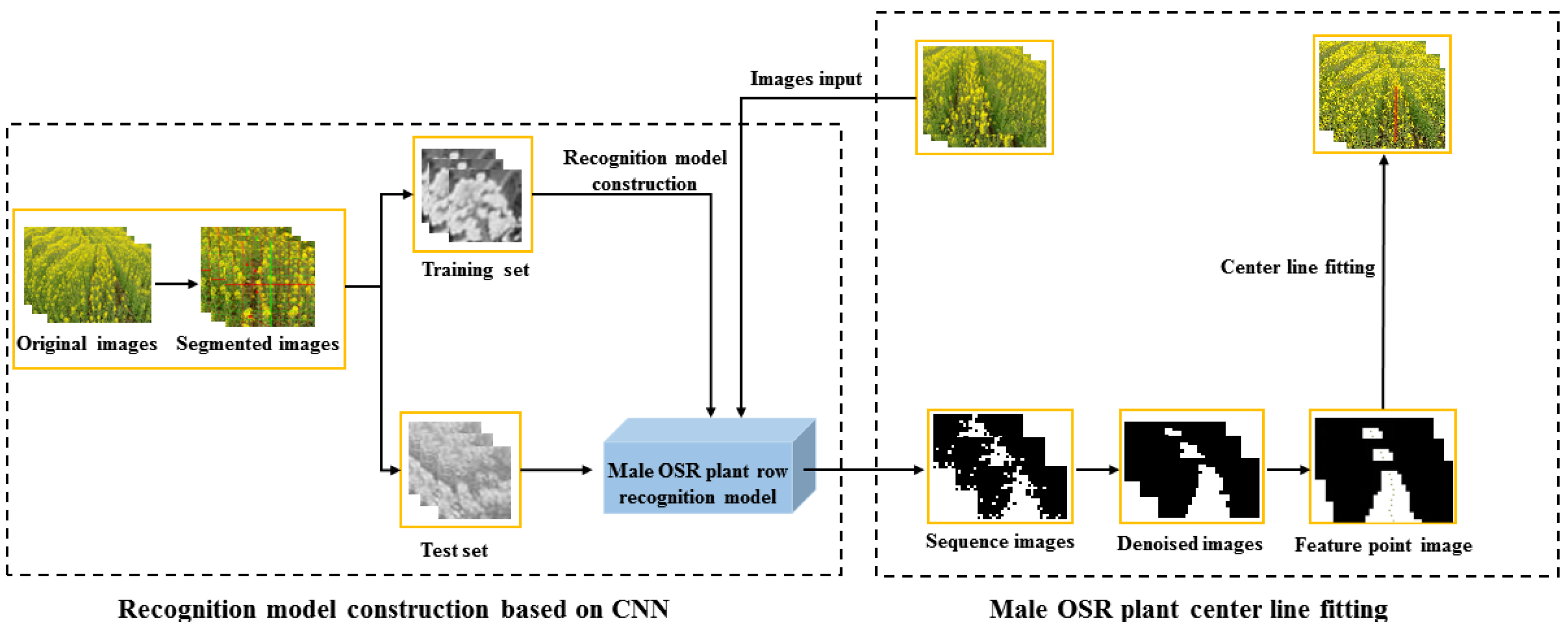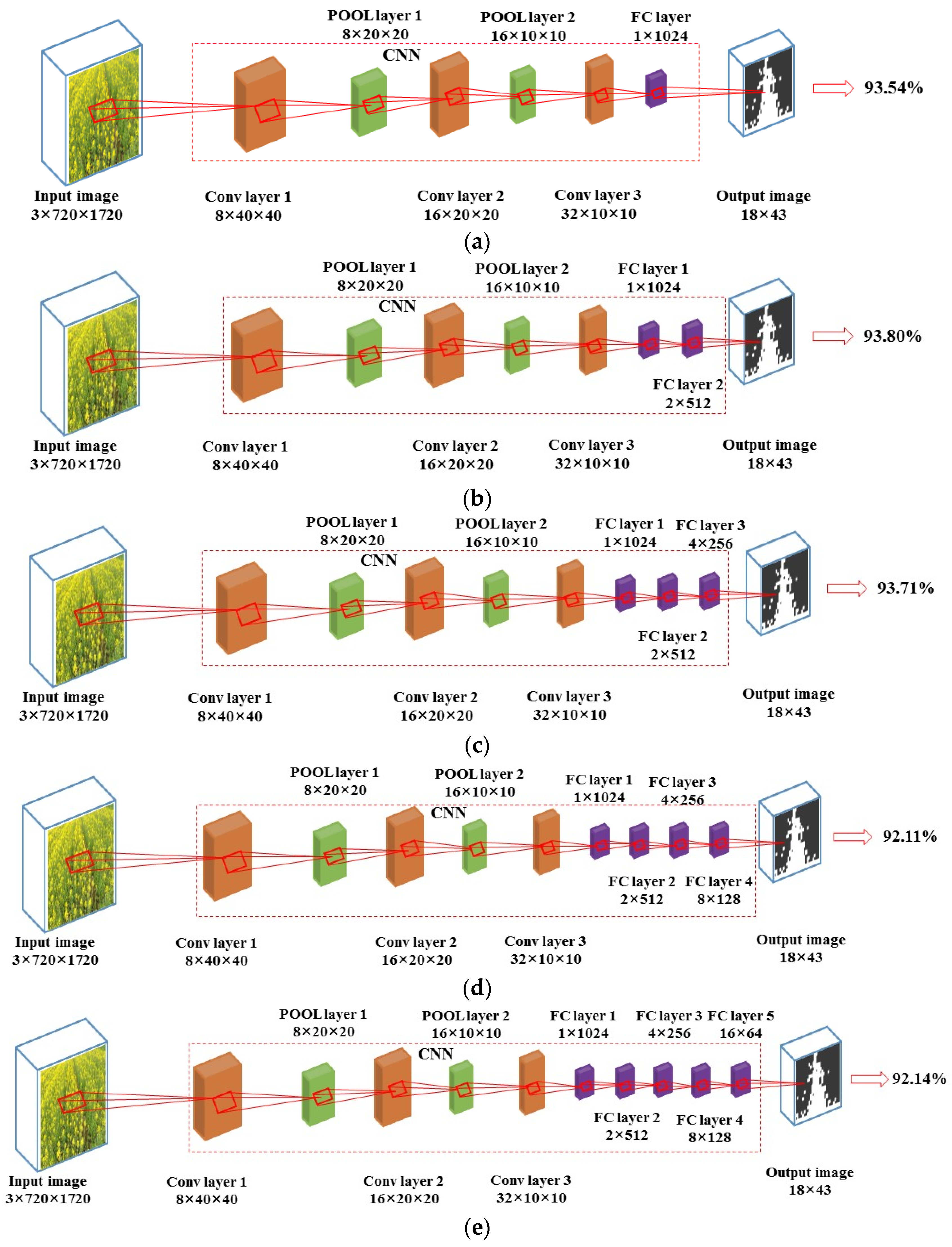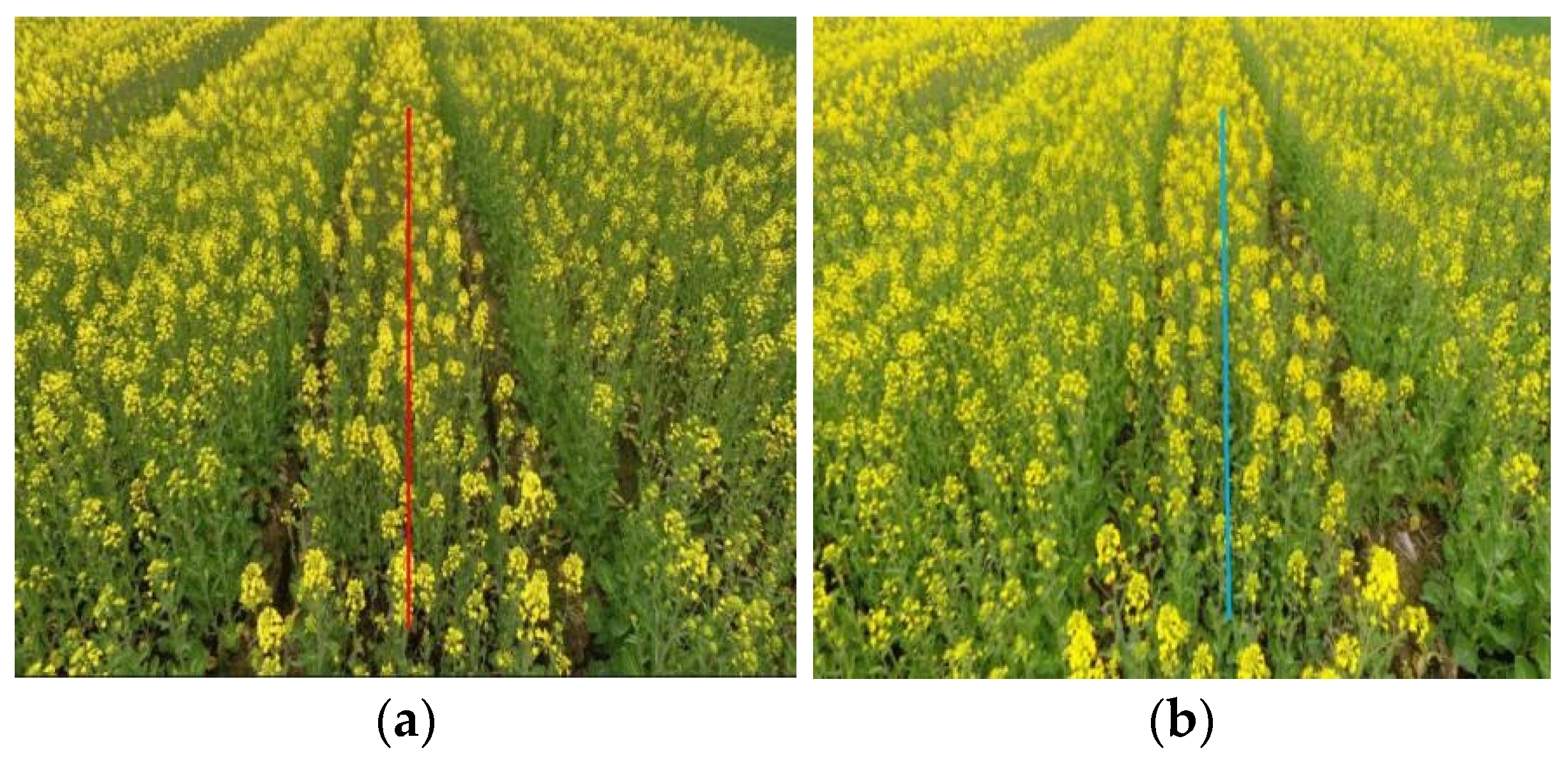Image Recognition of Male Oilseed Rape (Brassica napus) Plants Based on Convolutional Neural Network for UAAS Navigation Applications on Supplementary Pollination and Aerial Spraying
Abstract
:1. Introduction
2. Materials and Methods
2.1. OSR Plant Image Collecting Site, OSR Characters
2.2. Image Collecting UAV and Method
2.3. Image Processing Using CNN
2.3.1. Male OSR Plant Row Recognition Model Construction
2.3.2. Male OSR Plant Row Feature Point Extraction Method
2.3.3. Male OSR Plant Row Center Line Extraction and Fitting Method
3. Results
3.1. Effect of Different Segmented Training Image Size on CNN Model Accuracy
3.2. Recognition Accuracies of Different CNN Structures
3.3. Robustness Analysis of Different CNN Structures
3.4. Male OSR Plant Row Center Line Fitting
4. Discussion
5. Conclusions
6. Future Work
Author Contributions
Funding
Institutional Review Board Statement
Informed Consent Statement
Data Availability Statement
Conflicts of Interest
References
- Liu, Q.; Ren, T.; Zhang, Y.; Li, X.; Gong, R.; Liu, S.; Fan, X.; Lu, J. Evaluating the application of controlled release urea for oilseed rape on Brassica napus in a regional scale: The optimal usage, yield and nitrogen use efficiency responses. Ind. Crop. Prod. 2019, 140, 111560. [Google Scholar] [CrossRef]
- Lu, J. Scientifc Fertilization Technology for Oilseed Rape; God Shield Press: Beijing, China, 2010. [Google Scholar]
- Delgado, M.; Felix, M.; Bengoechea, C. Development of bioplastic materials: From rapeseed oil industry by products toadded-value biodegradable biocomposite materials. Ind. Crop. Prod. 2018, 125, 401–407. [Google Scholar] [CrossRef]
- Szubert, K. Synthesis of organofunctional silane from rapeseed oil and its application as a coating material. Cellulose 2018, 25, 6269–6278. [Google Scholar] [CrossRef] [Green Version]
- Shim, Y.; Falk, K.; Ratanapariyanuch, K.; Reaney, M.J.T. Food and fuel from Canadian oilseed grains: Biorefinery production may optimize both resources. Eur. J. Lipid Sci. Technol. 2017, 119, 1438–7697. [Google Scholar] [CrossRef]
- Cong, R.; Wang, Y.; Li, X.; Ren, T.; Lu, J. Differential responses of seed yield and yield components to nutrient deficiency between direct sown and transplanted winter oilseed rape. Int. J. Plant. Prod. 2020, 14, 77–92. [Google Scholar] [CrossRef]
- Vollmann, J.; Rajcan, I. Oilseed Rape in Oil Crops; Springer: New York, NY, USA, 2009; pp. 91–126. [Google Scholar]
- Requier, F.; Odoux, J.F.; Tamic, T.; Moreau, N.; Henry, M.; Decourtye, A.; Bretagnolle, V. Honey bee diet in intensive farmland habitats reveals an unexpectedly high flower richness and a major role of weeds. Ecol. Appl. 2015, 25, 881–890. [Google Scholar] [CrossRef] [Green Version]
- Zhang, S.; Cai, C.; Li, J.; Sun, T.; Liu, X.; Tian, Y.; Xue, X. The airflow field characteristics of the unmanned agricultural aerial system on oilseed rape (Brassica napus) canopy for supplementary pollination. Agronomy 2021, 11, 2035. [Google Scholar] [CrossRef]
- Zhang, S.; Xue, X.; Chen, C.; Sun, Z.; Sun, T. Development of a low-cost quadrotor UAV based on ADRC for agricultural remote sensing. Int. J. Agric. Biol. Eng. 2019, 12, 82–87. [Google Scholar] [CrossRef]
- Wang, X.; Wang, M.; Wang, S.; Wu, Y. Extraction of vegetation information from visible unmanned aerial vehicle images. Trans. Chin. Soc. Agric. Eng. 2015, 31, 152–159. [Google Scholar]
- Zhang, S.; Qiu, B.; Xue, X.; Sun, T.; Peng, B. Parameters optimization of crop protection UAS based on the first industry standard of China. Int. J. Agric. Biol. Eng. 2020, 13, 29–35. [Google Scholar] [CrossRef]
- Xue, X.; Lan, Y.; Sun, Z.; Chang, C.; Hoffmann, W. Develop an unmanned aerial vehicle based automatic aerial spraying system. Comput. Electron. Agric. 2016, 128, 58–66. [Google Scholar] [CrossRef]
- Ahmad, F.; Qiu, B.; Dong, X.; Ma, J.; Huang, X.; Ahmed, S.; Chandio, F.A. Effect of operational parameters of UAV sprayer on spray deposition pattern in target and off-target zones during outer field weed control application. Comput. Electron. Agric. 2020, 172, 105350. [Google Scholar] [CrossRef]
- Huang, X.; Zhang, S.; Luo, C.; Li, W.; Liao, Y. Design and experimentation of an aerial seeding system for rapeseed based on an air-assisted centralized metering device and a multi-rotor crop protection UAV. Appl. Sci. 2020, 10, 8854. [Google Scholar] [CrossRef]
- Cai, G.; Dias, J.; Seneviratne, L. A Survey of small-scale unmanned aerial vehicles: Recent advances and future development trends. Unmanned Syst. 2014, 2, 175–199. [Google Scholar] [CrossRef] [Green Version]
- Wang, G.; Wang, Q.; Luo, J. Positioning design of plant protection unmanned aerial vehicle based on Beidou navigation. Intell. Comput. Appl. 2017, 7, 46–49. [Google Scholar]
- Wang, Y. Research on autonomous navigation of agricultural UAV based on Beidou. Master’s Thesis, Northwest A & F University, Xi’an, China, 16 May 2017. [Google Scholar]
- Xu, B.; Chen, L.; Tan, Y.; Xu, M. Route planning algorithm and verification based on UAV operation path angle in irregular area. Trans. Chin. Soc. Agric. Eng. 2015, 31, 173–178. [Google Scholar]
- Huang, X.; Zhang, L.; Tang, L.; Li, X.; He, X. Path planning for autonomous operation of drone in fields with complex boundaries. Trans. Chin. Soc. Agric. Mach. 2020, 51, 34–42. [Google Scholar]
- Lan, Y.; Wang, L.; Zhang, Y. Application and prospect on obstacle avoidance technology for agricultural UAV. Trans. Chin. Soc. Agric. Eng. 2018, 34, 104–113. [Google Scholar]
- Zhou, J.; He, Y. Research progress on navigation path planning of agricultural machinery. Trans. Chin. Soc. Agric. Mach. 2021, 52, 1–14. [Google Scholar]
- Cao, G.; Li, Y.; Nan, F.; Liu, D.; Chen, C.; Zhang, J. Development and analysis of plant protection UAV flight control system and route planning research. Trans. Chin. Soc. Agric. Mach. 2020, 51, 1–16. [Google Scholar]
- Meng, Q.; Qiu, R.; He, J.; Zhang, M.; Ma, X.; Liu, G. Development of agricultural implement system based on machine vision and fuzzy control. Comput. Electron. Agric. 2015, 112, 128–138. [Google Scholar] [CrossRef]
- Yang, L.; Noguchi, N. Human detection for a robot tractor using omni-directional stereo vision. Comput. Electron. Agric. 2012, 89, 116–125. [Google Scholar] [CrossRef]
- Zhang, M.; Ji, Y.; Li, S.; Cao, R.; Xu, H.; Zhang, Z. Research progress of agricultural machinery navigation technology. Trans. Chin. Soc. Agric. Mach. 2020, 51, 1–18. [Google Scholar]
- Peng, S.; Kan, Z.; Li, J. Extraction of visual navigation directrix for harvesting operation in short-stalked and close-planting jujube orchard. Trans. Chin. Soc. Agric. Eng. 2017, 33, 45–52. [Google Scholar]
- Liu, Y.; Noguchi, N.; Liang, L. Development of a positioning system using UAV-based computer vision for an airboat navigation in paddy field. Comput. Electron. Agric. 2019, 162, 126–133. [Google Scholar] [CrossRef]
- Maravall, D.; Lope, J.D.; Fuentes, J.P. Vision-based anticipatory controller for the autonomous navigation of an UAV using artificial neural networks. Neurocomputing 2015, 151, 101–107. [Google Scholar] [CrossRef]
- Tang, Z.; Cunha, R.; Cabecinhas, D.; Hanel, T.; Silvstre, C. Quadrotor going through a window and landing: An image-based visual servo control approach. Control Eng. 2021, 112, 104827. [Google Scholar] [CrossRef]
- Opromolla, R.; Fasano, G. Visual-based obstacle detection and tracking, and conflict detection for small UAS sense and avoid. Aerosp. Sci. Technol. 2021, 119, 107167. [Google Scholar] [CrossRef]
- Available online: http://www.moa.gov.cn/govpublic/nybzzj1/201710/t20171011_5837449.htm (accessed on 1 November 2021).
- Ciocca, G.; Napoletano, P.; Schettini, R. CNN-based features for retrieval and classification of food images. Comput. Vis. Image Und. 2018, 176, 70–77. [Google Scholar] [CrossRef]
- Liu, Y.; Pu, H.; Sun, D.W. Efficient extraction of deep image features using convolutional neural network (CNN) for applications in detecting and analysing complex food matrices. Trends Food Sci. Tech. 2021, 113, 193–204. [Google Scholar] [CrossRef]
- Zhou, L.; Zhang, C.; Liu, F.; Qiu, Z.; He, Y. Application of deep learning in food: A review. Compr. Rev. Food. Sci. Food Saf. 2019, 18, 12492. [Google Scholar] [CrossRef] [PubMed] [Green Version]
- Paoletti, M.E.; Haut, J.M.; Plaza, J.; Plaza, A. Deep learning classifiers for hyperspectral imaging: A review. ISPRS J. Photogramm. 2019, 158, 279–317. [Google Scholar] [CrossRef]
- Si, Y.; Jiang, G.; Liu, G.; Gao, R.; Liu, Z. Early stage crop rows detection based on least square method. Trans. Chin. Soc. Agric. Mach. 2010, 41, 163–167 + 185. [Google Scholar]
- Zhang, Q.; Wang, J.; Li, B. Extraction method for centerlines of rice seedings based on YOLOv3 target detection. Trans. Chin. Soc. Agric. Mach. 2020, 51, 34–43. [Google Scholar]
- Sun, K.; Zhang, T. A New GNSS interference detection method based on rearranged Wavelet-Hough Transform. Sensors 2021, 21, 1714. [Google Scholar] [CrossRef]
- Zeng, H.; Lei, J.; Tao, J.; Zhang, W.; Liu, C. Navigation line extraction method for combine harvester under low contrast conditions. Trans. Chin. Soc. Agric. Eng. 2020, 36, 18–25. [Google Scholar]
- Guan, Z.; Chen, K.; Ding, Y.; Wu, C.; Liao, Q. Visual navigation path extraction method in rice harvesting. Trans. Chin. Soc. Agric. Mach. 2020, 51, 19–28. [Google Scholar]
- Yang, Y.; Zhang, B.; Zha, J.; Wen, X.; Chen, L.; Zhang, T.; Dong, X.; Yang, X. Real-time extraction of navigation line between corn row. Trans. Chin. Soc. Agric. Eng. 2020, 36, 162–171. [Google Scholar]








| Test Time | Growth Period | OSR Plant Mean Height (cm) | Width of OSR Plant Line (m) | Row Proportion of Male to Female | Mean Wind Speed (m/s) | Mean Temperature (°C) |
|---|---|---|---|---|---|---|
| 1–10 March 2021 | flowering | 100 ± 5 (male) 80 ± 5 (female) | 0.25 (male) 2.45 (female) | 4:6 | 0.50 ± 0.20 | 13.85 ± 0.30 |
| Items | Parameters |
|---|---|
| Total weight | 1375 g |
| Field of view (FOV) | Horizontal 60°, vertical ± 27° (front and rear) |
| 70° front and rear, 50° left and right (down) | |
| Camera sensor | 1 inch CMOS, 20 million effective pixels |
| Lens | 8.8 mm/24 mm, f/2.8–f/11 |
| Focus, aperture | Automatic |
| Image format and memory | JPEG, secure digital (SD) memory card |
| Shutter speed | 8–1/8000 s, electronic shutter, remote control trigger 8–1/2000 s, mechanical shutter |
| App for mobile devices | DJI GO 4 |
| Communication frequency | 2.4 GHz and 5.8 GHz |
| Segmented Size (pix × pix) | Training Accuracy (%) | ARMA (%) | LFV | TRT for Each Image (s) |
|---|---|---|---|---|
| 40 × 40 | 100 | 93.54 | 0.2059 | 0.06 |
| 20 × 20 | 100 | 90.86 | 0.3512 | 0.03 |
| 10 × 10 | 100 | 85.37 | 0.3222 | 0.02 |
| CNN Constructure | LFV |
|---|---|
| C1 + FC1 | 0.2918 |
| C2 + FC1 | 0.3655 |
| C3 + FC1 | 0.2059 |
| C4 + FC1 | 0.3227 |
| C5 + FC1 | 0.3601 |
| CNN Constructure | LFV |
|---|---|
| C3 + FC1 | 0.2059 |
| C3 + FC2 | 0.2367 |
| C3 + FC3 | 0.2561 |
| C3 + FC4 | 0.2754 |
| C3 + FC5 | 0.3011 |
| Method | Image Quantity | ARMA (%) | Average Single Image Time-Consume (s) |
|---|---|---|---|
| LSM | 200 | 97.50 | 0.20 |
| Hough transform | 200 | 85.50 | 0.26 |
| Weather Condition | Image Quantity | ARMA (%) | Average Single Image Time-Consume (s) | Average RMSE of Angle (°) |
|---|---|---|---|---|
| Cloudy day | 50 | 98 | 1.18 | 3.22 |
| Sunny day | 50 | 94 | 1.72 | 1.36 |
Publisher’s Note: MDPI stays neutral with regard to jurisdictional claims in published maps and institutional affiliations. |
© 2022 by the authors. Licensee MDPI, Basel, Switzerland. This article is an open access article distributed under the terms and conditions of the Creative Commons Attribution (CC BY) license (https://creativecommons.org/licenses/by/4.0/).
Share and Cite
Sun, Z.; Guo, X.; Xu, Y.; Zhang, S.; Cheng, X.; Hu, Q.; Wang, W.; Xue, X. Image Recognition of Male Oilseed Rape (Brassica napus) Plants Based on Convolutional Neural Network for UAAS Navigation Applications on Supplementary Pollination and Aerial Spraying. Agriculture 2022, 12, 62. https://doi.org/10.3390/agriculture12010062
Sun Z, Guo X, Xu Y, Zhang S, Cheng X, Hu Q, Wang W, Xue X. Image Recognition of Male Oilseed Rape (Brassica napus) Plants Based on Convolutional Neural Network for UAAS Navigation Applications on Supplementary Pollination and Aerial Spraying. Agriculture. 2022; 12(1):62. https://doi.org/10.3390/agriculture12010062
Chicago/Turabian StyleSun, Zhu, Xiangyu Guo, Yang Xu, Songchao Zhang, Xiaohui Cheng, Qiong Hu, Wenxiang Wang, and Xinyu Xue. 2022. "Image Recognition of Male Oilseed Rape (Brassica napus) Plants Based on Convolutional Neural Network for UAAS Navigation Applications on Supplementary Pollination and Aerial Spraying" Agriculture 12, no. 1: 62. https://doi.org/10.3390/agriculture12010062






